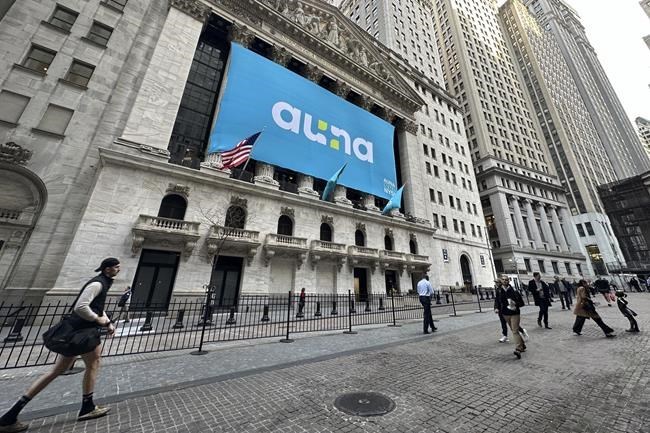NEW YORK (AP) — U.S. stocks fell on worries that what seemed like a blip in the battle to bring down inflation is turning into a trend. The S&P 500 lost 0.9% Wednesday. The Dow Jones Industrial Average gave back 1.1%, and the Nasdaq composite fell 0.8%. Treasury yields also leaped in the bond market, raising the pressure on the stock market. Traders pulled back on bets for coming cuts to interest rates by the Federal Reserve following a third straight inflation report that came in hotter than expected. The yield on the 10-year Treasury jumped to 4.55%.
THIS IS A BREAKING NEWS UPDATE. AP’s earlier story follows below.
NEW YORK (AP) — U.S. stocks are sinking Wednesday on worries that what seemed like a blip in the battle to bring down inflation is turning into a trend.
The S&P 500 was 1% lower in a wipeout where roughly nine out of 10 stocks in the index fell. The Dow Jones Industrial Average was down 467 points, or 1.2%, as of 2:04 p.m. Eastern time, and the Nasdaq composite was 0.9% lower.
Treasury yields also leaped in the bond market, raising the pressure on the stock market, after a report showed inflation was hotter last month than economists expected. It’s the third straight report to suggest progress on bringing high inflation down may be stalling.
“There are still embers of inflation here and there in the economy,” said Joe Davis, chief global economist at Vanguard.
For shoppers, that’s painful because of the potential for even higher prices at the store. For Wall Street, that’s painful because it could convince the Federal Reserve to hold back on delivering the cuts to interest rates that traders are craving and have been betting on.
The S&P 500 had already leaped more than 20% since Halloween in part on expectations that the Federal Reserve would lower its main interest rate, which is sitting at its highest level in more than two decades. Such cuts would relax the pressure on the economy and encourage investors to pay higher prices for stocks, bonds, cryptocurrencies and other investments.
But the Fed has been waiting until it saw more evidence inflation was heading sustainably down toward its goal of 2%. After an encouraging cooling last year, the fear now is that inflation may be stuck after January’s, February’s and March’s inflation reports all came in hotter than expected, along with data on the economy generally.
“Two data points don’t make a trend, but maybe three do,” said Brian Jacobsen, chief economist at Annex Wealth Management.
“If we get one more reading like this, Fed chatter will shift from when to cut to whether to hike.”
Prices for everything from bonds to bitcoin to gold fell immediately after the morning’s release of the inflation data.
The yield on the 10-year Treasury jumped to 4.54% from 4.36% late Tuesday. The two-year yield, which moves more on expectations for Fed action, climbed to 4.95% from 4.74%.
Traders sharply cut back on bets that the Fed could begin cutting rates in June. They now see a 17% chance of that, down from nearly 74% a month ago, according to CME Group’s FedWatch tool.
Perhaps more importantly, traders shifted more bets toward the Fed cutting rates just twice over the course of this year. At the start of the year, they were forecasting six or more cuts through 2024.
High interest rates work to undercut inflation by slowing the economy and hurting investment prices. The fear is that rates left too high for too long can cause a recession.
Wall Street’s biggest losers included real-estate investment trusts, utility companies and other stocks that tend to get hurt most by high interest rates.
Real-estate stocks in the S&P 500 fell 4.3% for the biggest loss by far among the 11 sectors that make up the index. That included a 5.7% drop for office owner Boston Properties and a 5.3% tumble for Alexandria Real Estate Equities.
Critics had already been saying the U.S. stock market looked too expensive by several measures. Either interest rates needed to fall or profits for companies needed to rally to make stock prices look more reasonable. The hope on Wall Street is that the resilient U.S. economy could help prop up profits, even if it does diminish hopes for rate cuts.
Big U.S. companies are lining up on the runway to say how much profit they earned during the first three months of the year, and Delta Air Lines helped kick off the reporting season by delivering stronger-than-expected results.
The airline said it's seeing strong demand for flights around the world, and it expects the strength to continue through the spring. Its stock climbed as much as 4% during the morning before flipping to a loss of 2%. Other airline stocks were also slipping, including a 2% loss for United Airlines.
The banking industry will soon take the spotlight in earnings season, with JPMorgan Chase and Wells Fargo among those reporting on Friday.
In stock markets abroad, indexes were mixed across much of Europe. In Asia, stocks rose 1.9% in Hong Kong but fell 0.7% in Shanghai after Fitch Ratings lowered its outlook for China’s public finances.
___
AP Business Writers Matt Ott and Elaine Kurtenbach contributed.
Stan Choe, The Associated Press




